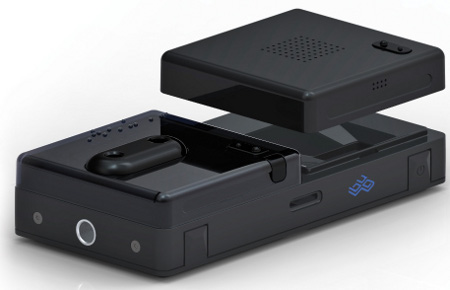Ultra-secure version of modular, hackable BugBase on the way
Mar 14, 2011 — by Eric Brown — from the LinuxDevices Archive — 3 viewsBug Labs and Pitney Bowes announced a mobile device development platform featuring hardware-level security and security life-cycle management services. Based on Bug Labs' Linux-and Android-ready, OMAP3530-based BugBase 2.0 platform, BugSecure integrates a tamper-responding security chip from Pitney Bowes.
BugSecure is designed for "prototyping, piloting, and producing" secure machine-to-machine (M2M) wireless and networked devices that require a high-level of assurance, such as those in the financial, pharmaceutical, medical, regulatory, and metering industries, says Bug Labs.
BugSecure provides a deeper level of tamper-proof security by protecting the device's hardware and operating system, not just its application software, says the company. Bug Labs did not offer images or specs for the BugSecure, but says it is based on its BugBase 2.0 (pictured below), a second-generation version of its compact, modular Linux-based hardware system announced last year.

BugBase 2.0
(Click to enlarge)
BugSecure further integrates an unnamed, tamper-responding security chip from Pitney Bowes, used in the latter's mailing/postage machines. The crypto-chip provides cryptographic processing, a secure time source, transaction management, remote security lifecycle management, and third party server validation, says Bug Labs.
The chip's tamper-proof, cryptographic key store is said to provide a highly secure source for encryption keys for digital signatures. This is said to be required for applications where the risk of fraud is high, or there is a need for a "bulletproof audit trail," says the company.
The technology is related to Pitney Bowes' Postal Security Device (PSD) technology, which is touted for eliminating the need to perform physical inspections of mailing systems. PSD contains the funds and performs all calculations necessary to print meter stamps that comply with current USPS standards, says Pitney Bowes.
BugBase 2.0 background
The BugBase 2.0 that forms the basis for BugSecure measures 5.1 x 2.55 x 0.76 inches, and weighs 4.5 ounces when not loaded with one of its many plug-in modules. Version 2.0 moved up to a Texas Instruments Cortex-A8-based OMAP3530 system-on-chip (SoC) clocked at 600MHz and also added support for Android. It continues to offer a Poky Linux distribution, now incorporating Linux 2.6.31.
BugBase 2.0 ships with a 2GB flash card in its system microSD slot, which can be expanded up to 32GB. Another 32GB is available via an external SD slot designed for user data, says Bug Labs.
The device ships with 802.11b/g wireless networking, with support for mesh, AP, ad-hoc, and managed modes, says Bug Labs. There's also built-in Bluetooth 2.0, a 3.5mm audio jack, as well as a mini-USB port that supports both host and On-The-Go modes.
The BugBase 2.0 is further equipped with a proprietary, 30-pin "BugStinger" connector that provides USB host, Ethernet, and serial port replication, says Bug Labs. This hooks up to a relatively new BugStinger debugging module. The device also provides four LEDs, an on/off button, and a user-programmable button, and features a 3.7V, 1500mAh Li-ion battery.

Professional BugBundle with BugBase 2.0 (center) and a variety of add-on modules, including the new BugStinger debugging device (top)
Additional modules include BugLocate (GPS), the BugCam (three-megapixel camera), and a BugUSB module that supports dongles including an available 3G USB Dongle. Development-oriented modules include the BugStinger debug module, and a BugVonHippel breakout board module that offers additional interfaces and power options.
The BugBase is also offered in a variety of discounted bundles that include various selections of modules, including the top-of-the-line, $1,600 Professional BugBundle (pictured above). It would appear, meanwhile, that Bug Labs has discontinued some previous modules, including BugMotion (motion detector and accelerometer), BugSounds (audio I/O), and BugBee (ZigBee/802.15.4).
Bug Labs continues to invite hardware and software developers to contribute to the open source project, designing hardware and software modules, and sharing their work back into the community. The company has also signed several deals offering customization and vertical market solutions to companies, such as Accenture.
Stated Peter Semmelhack, founder and chief executive officer, Bug Labs, "Until now, enterprises have been reliant on software-based security measures for their applications. Since these measures do not execute within a trusted hardware environment, system security can be compromised by malicious programs, rogue code or even user actions."
Stated Joseph Timko, executive vice president and chief strategy and innovation officer, Pitney Bowes, "By teaming up with Bug Labs, we can now offer device development platforms with the same security technology that has been used in Pitney Bowes mailing systems to secure funds for decades."
Availability
Bug Labs did not announce when the BugSecure would be available, or at what price, but says it will demonstrate the product at CTIA Wireless 2011 in Orlando, Florida Mar. 22-24, in booth #3659.
Bug Labs has yet to post a BugSecure page, but more information on the underlying BugBase 2.0 platform may be found at Bug's BugBase 2.0 page and more on the modules may be found at the BugStore.
More information on Pitney Bowes technology may be found at the Pitney Bowes web-site.
This article was originally published on LinuxDevices.com and has been donated to the open source community by QuinStreet Inc. Please visit LinuxToday.com for up-to-date news and articles about Linux and open source.